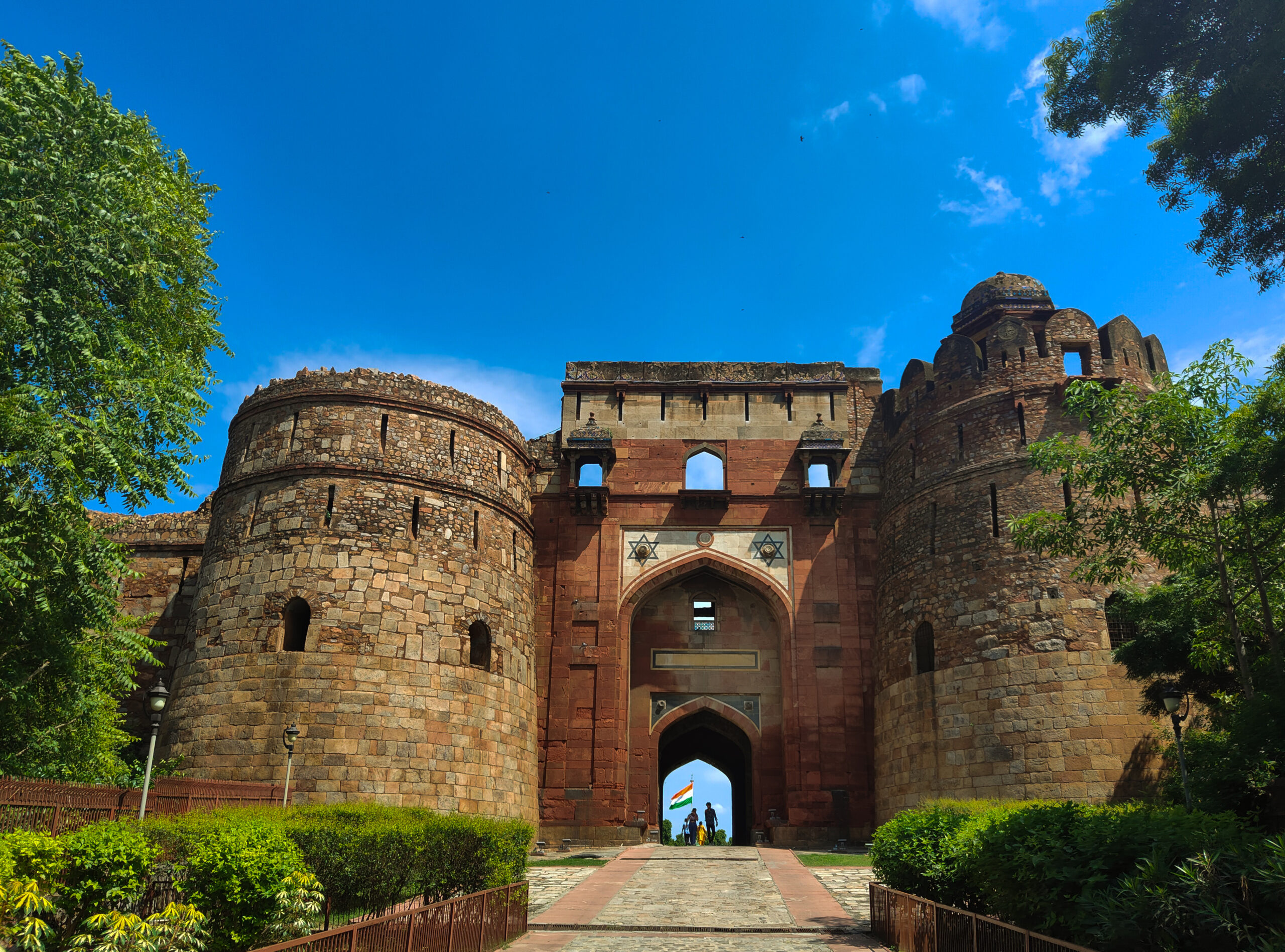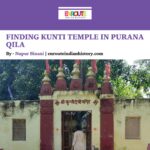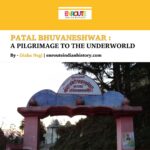
“महाबलाः जङ्गमयुक्ता भूमिः पाण्डवैः परिणता, फलतः इन्द्रप्रस्थस्य निर्माणम् अभवत्”
The mighty forested Indraprastha was once capital of Pandavas, the heroes of Mahabharta. As our Puranas recount, after the Pandavas lost the game of dice, they were exiled for 13 years from their kingdom of Hastinapur. During this time, they discovered a barren, rocky land in present-day Delhi. Through their intelligence, wisdom, and determination, they transformed it into fertile agricultural land, establishing their capital, Indraprastha.
Today, this area is part of modern Delhi and is home to significant landmarks, from the Supreme Court to Purana Qila, commonly known as Pandavas Qila. Throughout history, numerous emperors have sought to assert their dominance, leading to the construction and reconstruction of Purana Qila by various dynasties. It is now the most extensively excavated open site in Delhi, shrouded in mystery to this day. The Old Fort stands as a testament to the struggles of the past, embodying a site of contention over its identity as either a Muslim or Hindu fort, which has affected the beliefs and rituals of millions.

Before stepping ourselves into the historical and spiritual significance, it is important to understand the excavated, known history of Indraprastha and Old fort. Analysing various textual sources, different scholars and excavations by Archaeological Survey of India, walls of Purana Qila narrates its story from the period of 1540s. Sher Shah Suri (1538-45) demolished the city of Dinpanah built by Humayan and on the same site raised this citadel, with bastions on the corners and in the western walls. The ramparts extend over 2km with 3 main gates in north, south and west directions, the last one functioning as entrance now. These gates are double- storeyed built with red sandstone and surmounted by chhatris, among the three main gates, the northern one is called “Talaqi- Darwaza” meaning the forbidden gate. Above the oriel windows on its front are carved marble leogryphs engaged in combat with a man, the southern door is named as “Humayun Darwaza” showcasing another story, it is believed Sher Shah Suri left the Purana Qila unfinished which was later completed by Humayun supplemented by scribblings found on recess of gate. The Old Fort originally lay on the bank of the Yamuna, the general depression on the northern and western sides of the fortress suggests that a wide moat connected with the river existed on these sides.
The beautiful Indraprastha is once again a barren, rusted land of controversy. With the tussle of mediaeval history, historians forgot to trace back the existence of ancient land. Today, many seek to claim the land as associated with Humayun or Sher Shah Suri, but what about the ancient Pandavas? Due to a lack of textual and excavated sources, we often overlook Pandavas Qila, dismissing it as merely a mythical site but the richness of Indian heritage lies in the eyes of people. The presence of Kunti Temple inside the purana qila is the testament of our heritage, our belief and our faith.
When I arrived at Purana Qila, Google Maps didn’t provide directions to Kunti’s temple. Following the guidance of a female guard, I headed towards the fort’s museum, and there it was. In front of the museum, a large lawn showcased ancient architecture. An old red and white house, nestled among Ashoka trees, transports you back to the era of the Mahabharata as you step into the ancient temple. A no storey, simple structure in between the mighty Mughal architecture sparked my curiosity which led to talk to the localite, Mr. Amit Bhardwaj has been living inside the temple since his childhood. His knowledge, experience and connections helped us to construct the lost history of the broken, damaged temple.
Kunti, the mother of the Pandavas and a devoted worshipper of Shiva, is honoured in the Kunti temple in Indraprastha. This sacred site is where she would worship Lord Shiva, while the Pandavas, being devotees of Shakti, contribute to the temple’s dual significance as a Shiv-Durga temple.
Amit Bhardwaj emphasised the architectural significance of the temple. Instead of a single tall shikhara, the entrance features five smaller shikharas adorned with Hindu symbols like the Swastika and Om. He pointed out the structural differences between the shikharas of the Shiva and Durga temples. While both are part of the same complex, the Shiva temple has a dome design that reflects Indo-Islamic influences, whereas the shikhara of the Durga temple showcases characteristics of ancient northern architecture. During our conversation, he noted that the current base of the temple was constructed a few years ago, while the original shivling was located deeper below.
In our further conversation, Amit discussed the communities that continue to hold this sacred site in reverence. He explained that when Indraprastha was a village, people would visit daily. However, with their displacement to Nangal Village near Sarai Kale Khan, their visits have diminished. Still, many return, especially during Navratri, the nine-day grand festival dedicated to the worship of Shakti, Durga, and Kali.
“We are in constant fight for proving this fort to be Hindu or Musilm, but in this tussle we have forgotten the belief and faith of people, this living temple of Kunti serves as a testament to that.” Amit Bhardwaj emphasised the need to preserve the hidden, rich heritage of our country.
The temple is believed to be blessed by Hinglaj Devi, identified in our scriptures as Sati, the first wife of Shiva. Additionally, Narayani Devi, one of Maa Durga’s incarnations and regarded as the Kuldevi of the Charan caste, is also worshipped here. This draws devotees from other states seeking blessings at this sacred site. Amit Bhardwaj mentioned that there was once a path connecting the Old Fort to Bharion Mandir, where Bheem, one of the Pandavas, would worship before the Mahabharata war. However, this route has recently been closed by the government.
The main shivling is covered by a tomb structure and newly laid tiles, but there is also another shivling located diagonally between the Shiva and Durga temples. At first glance, I thought the five stones represented the five Pandava brothers. However, upon further inquiry, I learned that these stones actually symbolise Shiva’s family: with Shiva at the centre, surrounded by Ganesha, Kartikeya, Gauri, Nandi, and Vasukinath.
A similar practice can be seen during the Bhakti period in Southern India, known as Panchayatana Puja, which involves the worship of five deities: Shiva, Vishnu, Devi, Surya, and Ganesha.
While we couldn’t draw a definitive conclusion about this practice, the fresh flowers on the religious stone serve as evidence of its continued significance.
The most striking feature of Shivling present in Kunti’s temple was the non-presence of Nandi, without whom Shiva is considered incomplete. Today, many temples have turned into sources of income, with significant funds allocated for elaborate, decorative, and costly architecture. Yet, deep in the forests of our capital city lies a humble temple, whose walls resonate with faith and belief, having witnessed a rich legacy of heritage.
With our continued conversation with Amit Bhardwaj, he showcased us a recently excavated site in front of the temple. The ongoing excavations at the site that began in mid- January this year, is expected to shed some light on that era. The clue that the Archaeological Survey of India (ASI) members are looking for is to establish a relation of grey ware pottery with the Mahabharata period, a sculpture of Gajalakshmi have also been founded once again raising the question on the Sher Shah Suri’s Pandavas Qila.
In the last three months they have found a rare 18 cm tall, 12th century sandstone sculpture of Vishnu of Rajput period, a seal in terracotta from the Gupta period, miniature stone images of Ganesha from the Mughal period, pottery of the Kushan and Gupta periods, terracotta human and animals figurines, sherds of (NBPW) and (PGW), ivory pendants, charred grains and structures from Gupta period.
Vasant Kumar Swarnkar, Superintending Archaeologist, Archaeological Survey of India (Delhi Circle), who is seeing the project, said that, “Every artefact is distinct to the time it was made. For eg, The knife faced rim pattern and the shapes of the pots, those found during the excavations dates back to architecture of the Rajput and Gupta period, Now, we are looking for the main clue, the Painted Grey Ware (PGW), a specific pottery type that the archaeologists associate with the Mahabharata period. Excavating 1.5 metres more is expected to expose the lowest cultural settlement that was there.”
“In historical times, human settlements were either close to river banks or to a source of water. The excavation spot at Purana Qila is identified because of its proximity to the original flow of the Yamuna, and we are confident of finding some evidence of human settlement there,” said Vasant K Swarankar.
There is a Baoli present in the passage between Kila-e- Kuhna and Kunti mandir, made of red sandstone; it is said the Baoli was constructed by Humayun while developing the city Dinapanah. The striking location of Baoli near the temple raises a question, was it used as a source of water from Mahabharata period? Did Kunti use it as a source to fetch water while worshipping shivling? Though, there has been no such mention found but it does open chapter for contradictory historical perspective.
As our conversation continued, Amit Bhardwaj suggested that we should visit Sheetala Mata Mandir, located on the same lane. However, as I walked down the lane, I couldn’t locate the temple and had to ask a guard for directions. It was then that I realised there was no distinct temple structure; instead, there was a faded, distorted image beneath a large peepal tree, accompanied by a few pots and scattered stones. “Sheetala” meaning cool, is the incarnation of Maa parvati worshipped in the Northern region and she is considered as goddess to cure poxes, sores, ghouls, pustules, smallpox and diseases. The most disturbing thing was the construction of a public washroom aside from the idols, such lack of preservation questions the beliefs of millions. An ancient site that has witnessed numerous dynasties is bound to be surrounded by controversy. Each time a new artefact is discovered, historians delve deeper into the past. However, when a sacred site loses its heritage in the name of development, it raises important questions about our history. Despite numerous attacks, destruction, and reconstructions, people continue to uphold their rituals, traditions, and beliefs. This is especially evident in the communities that worship Sheetala Mata under a peepal tree, where the lack of a formal structure does not diminish their faith. Their devotion to their deity remains stronger than any unknown archaeological evidence.
“These archaeological excavations started in 1954-55 and were carried out until 1969 to 1973 at the traditionally known site of the city of Indraprastha mentioned in the Mahabharata. In a trial excavation of 1954-55 sherds of the Painted Grey Ware (PGW) and remains of the Sunga Kushan periods were found. The remains have indicated a Painted Grey Ware Culture which predates the early historic period. Between 1969-70 to 1972-73, large-scale excavations revealed remains of eight periods with a continued stratigraphical horizon from Early historic period representing the Northern Black Polished Ware (NBPW) period (C. 600-300 В.С.) followed by Sunga, Saka- Kushan, Gupta, Post-Gupta and Rajput period followed by Sultanate and Mughal period with interesting and significant structures and antiquities.”
We live in a mirage, where what we see often isn’t the whole truth, and what remains unseen isn’t merely mythological. For centuries, we’ve debated the significance of Purana Qila, often dismissing Indraprastha as a mythical site referenced in Hindu scriptures. However, the real question transcends religion and delves into heritage. The presence of Kunti Temple is not just a religious site for Hindus; it stands as a living testament to an unknown history. This heritage deserves to be examined through the perspective of an awakened historian.
It was Kunti’s belief and faith in the Supreme God that inspired her to worship her deity, and this same hope continues to guide us today as we uphold the same rituals and worship in the same temple.
As Lord Krishna stated in Bhagavad Gita, Verse 4, Chapter 6-7;
“यदा यदा धर्मस्य पतनं अधर्मस्य च वृद्धिः भवति तदा तदा अहं जगति स्वयं भवति”
“Whenever there’s a fall of righteousness and an increase in unrighteousness, O Bharata, at that point I occur myself in the universe”
References-:
- Y.D. Sharma.Delhi and its neighbourhood.Archaeological Survey of India. 2001.Pg 122-128.
- Anuja Jaiswal.The Times of India.ASI plans to dig more deeper into Purana Qila
- Nupur Binani. Oral Testimony from localite




















